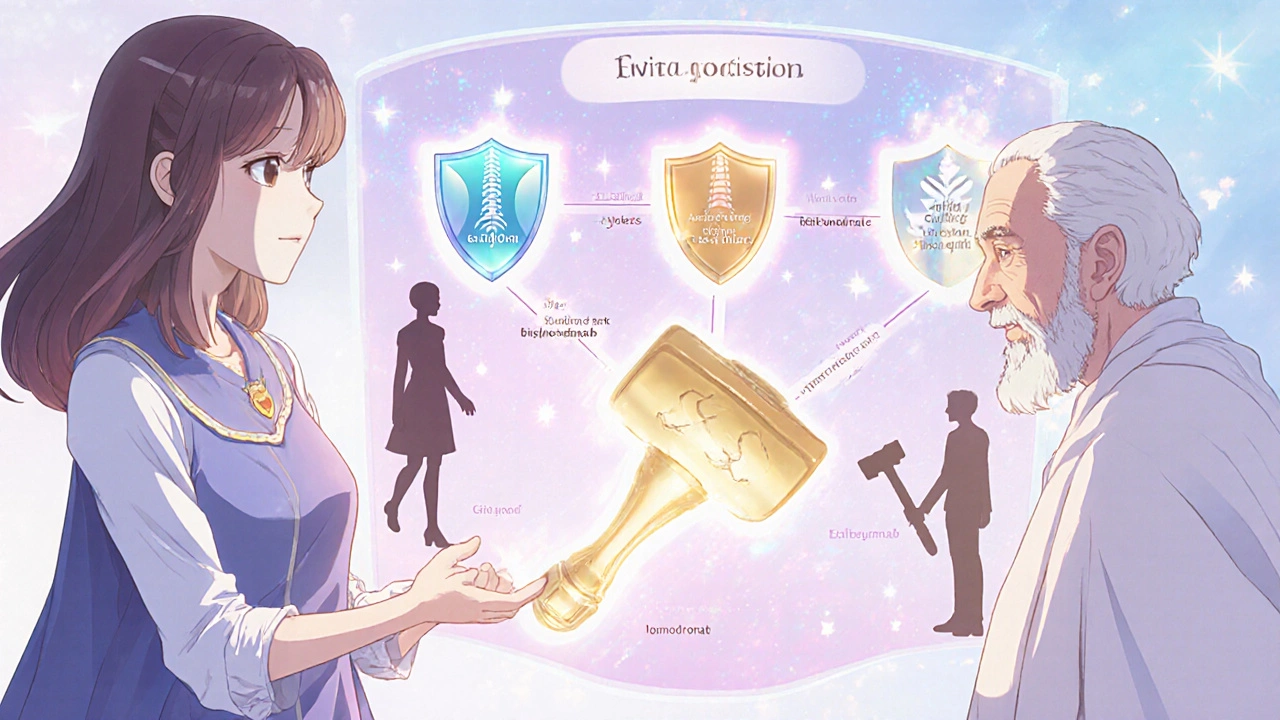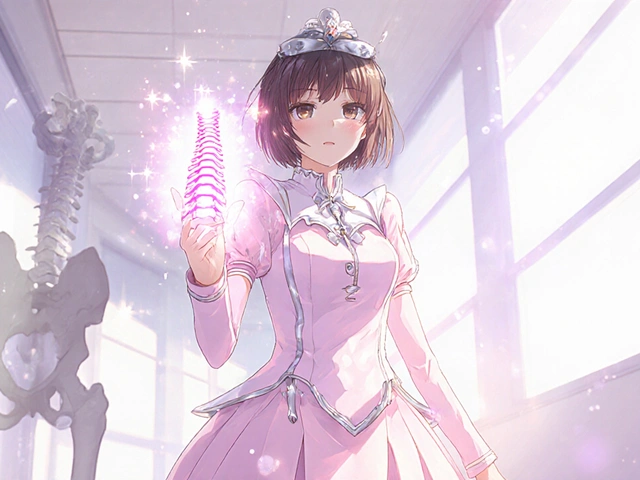Osteoporosis Treatment Selector
Find Your Best Treatment Option
Select your health characteristics below to see which osteoporosis treatment may be most appropriate for you.
Quick Takeaways
- Evista (raloxifene) is a selective estrogen receptor modulator (SERM) that lowers spine fracture risk but does not prevent hip fractures.
- Bisphosphonates (e.g., alendronate, risedronate) are first‑line for most patients because they cut both spine and hip fractures.
- Denosumab (Prolia) works via RANKL inhibition and is useful for people who can’t tolerate oral bisphosphonates.
- Romosozumab (Evenity) is a newer bone‑forming antibody for high‑risk patients, but it’s pricey and requires monitoring.
- Supplements (calcium + vitamin D) are essential backbones for any regimen but won’t replace prescription drugs.
What Is Evista (Raloxifene) and How Does It Work?
When you first hear the name Evista, you might picture a typical osteoporosis pill, but it’s actually a Raloxifene is a selective estrogen receptor modulator (SERM) that mimics estrogen’s bone‑protective effects without stimulating breast or uterine tissue. Approved by the FDA in 1998, Evista is taken as a 60 mg tablet once daily.
Raloxifene binds to estrogen receptors on bone cells, decreasing bone resorption and modestly increasing bone formation. The net result is a 30-50 % reduction in vertebral (spine) fractures, but data show little impact on non‑vertebral sites like the hip.
Because it’s a SERM, Evista also lowers LDL cholesterol and can reduce the risk of invasive breast cancer in post‑menopausal women. However, it raises the chance of deep‑vein thrombosis (DVT) and may cause hot flashes.
Top Prescription Alternatives
Below are the most frequently prescribed osteoporosis drugs that clinicians compare against Evista. Each has a distinct mechanism, dosing schedule, and safety profile.
Alendronate (Fosamax)
Alendronate is a nitrogen‑containing bisphosphonate that binds to hydroxyapatite in bone, inhibiting osteoclast‑mediated resorption. Typical dose: 70 mg once weekly. FDA‑approved in 1995.
Risedronate (Actonel)
Risedronate works the same way as alendronate but offers a flexible dosing option - 35 mg once weekly or 150 mg once monthly - making adherence easier for some patients.
Denosumab (Prolia)
Denosumab is a monoclonal antibody that blocks RANKL, a key signal that tells osteoclasts to break down bone. Given as a subcutaneous injection every 6 months. FDA approval came in 2010 for osteoporosis.
Romosozumab (Evenity)
Romosozumab is a humanized antibody that both inhibits bone resorption (via sclerostin inhibition) and stimulates bone formation. Administered monthly for 12 months, then followed by anti‑resorptive therapy.
Ibandronate (Boniva)
Ibandronate is another bisphosphonate, usually taken as a 150 mg tablet once a month or as an IV infusion every three months.
Calcitonin (Miacalcin)
Calcitonin is a peptide hormone that slows bone loss; it’s available as a nasal spray or injection and is often reserved for patients who cannot tolerate other drugs.
Calcium + Vitamin D Supplements
While not a prescription medication, adequate intake of calcium (1,000-1,200 mg daily) and vitamin D (800-1,000 IU) is the foundation of any bone‑health plan.

Side‑Effect Summary Across Options
Understanding side‑effects helps you match a drug to a patient’s health profile. Below is a quick matrix that captures the most common adverse events for each class.
| Medication | Typical Side‑Effects | Serious Risks |
|---|---|---|
| Evista (Raloxifene) | Hot flashes, leg cramps | DVT/PE, stroke (rare) |
| Alendronate | Esophageal irritation, abdominal pain | Osteonecrosis of the jaw (ONJ), atypical femur fracture |
| Risedronate | Similar GI symptoms as alendronate | ONJ, atypical fracture |
| Denosumab | Injection site reactions, hypocalcemia | ONJ, severe infections |
| Romosozumab | Injection site pain, mild flu‑like symptoms | Potential cardiovascular events (caution in patients with heart disease) |
| Ibandronate | Acute phase reaction (flu‑like), GI upset | ONJ, atypical fracture |
| Calcitonin | Nasal irritation, nausea | Limited efficacy; rarely used as sole therapy |
Efficacy at a Glance
Clinical trials have measured each drug’s ability to cut fracture risk. Percent reductions are approximate and come from large‑scale, FDA‑mandated studies.
| Medication | Spine Fracture Reduction | Hip Fracture Reduction | Key Study Year |
|---|---|---|---|
| Evista (Raloxifene) | 30-45 % | ~0 % | 2001 (MORE trial) |
| Alendronate | 45-55 % | 40-50 % | 1999 (FIT trial) |
| Risedronate | 41 % | 38 % | 2002 (VIVE trial) |
| Denosumab | 68 % | 40 % | 2010 (FREEDOM trial) |
| Romosozumab | 73 % | 50 % | 2019 (ARCH trial) |
Choosing the Right Option for You
Every patient’s situation is unique. Below is a practical guide that lines up the most common clinical scenarios with the drug that usually fits best.
- Post‑menopausal women with isolated vertebral fragility and a personal or family history of breast cancer: Evista shines here because it offers bone protection plus a modest breast‑cancer risk reduction.
- Patients needing both spine and hip protection, especially those with prior hip fracture: Oral bisphosphonates (alendronate or risedronate) are first‑line due to robust evidence for both sites.
- Individuals with severe GI intolerance or esophageal strictures: Denosumab’s injection route bypasses the stomach entirely.
- High‑risk patients (multiple prior fractures, very low BMD) who can afford a newer agent: Romosozumab provides the biggest absolute gain in BMD and fracture reduction, but watch cardiovascular history.
- Elderly patients on many pills who struggle with weekly dosing: Ibandronate’s monthly tablet or quarterly IV can simplify regimens.
- Those with a clotting disorder or a personal history of DVT/PE: Avoid Evista, as its SERM class raises clot risk.

Practical Checklist Before Starting Therapy
- Confirm menopause status and baseline BMD (DXA scan).
- Review calcium and vitamin D intake; supplement if needed.
- Screen for contraindications: esophageal disorders, renal impairment (<90 mL/min), history of clotting, active infection.
- Discuss lifestyle: weight‑bearing exercise, smoking cessation, alcohol moderation.
- Choose the medication that matches fracture‑site goals, comorbidities, and adherence capacity.
- Schedule follow‑up DXA in 1-2 years to gauge response.
Frequently Asked Questions
Can I take Evista and a bisphosphonate at the same time?
No. Combining two bone‑active agents has not shown additional benefit and raises the risk of side‑effects. Doctors usually pick one based on the patient’s risk profile.
How long should I stay on Evista?
Many clinicians continue for 5 years or longer as long as bone density stays stable and no serious side‑effects appear. Annual re‑evaluation is recommended.
Is Denosumab safe for people with kidney disease?
Denosumab does not rely on renal clearance, so it can be used in patients with moderate to severe kidney impairment, but calcium levels must be monitored closely.
Do I need a prescription for calcium supplements?
No prescription is required. Over‑the‑counter calcium carbonate or citrate, paired with vitamin D3, works for most adults. Choose the form that’s easier on the stomach.
What should I do if I miss a dose of Evista?
Take the missed tablet as soon as you remember, unless it’s almost time for the next dose. Never double up, and continue with the regular schedule.
Bottom Line
Evista (raloxifene) offers a solid option for women focused on spinal health and who also want a modest breast‑cancer protective effect. However, if hip protection, overall fracture risk reduction, or cost is the primary concern, bisphosphonates, denosumab, or romosozumab usually take the lead. Use the checklist, compare the side‑effect profiles, and have an open conversation with your healthcare provider to land on the regimen that best fits your life.


Sakib Shaikh
October 21, 2025 AT 16:46Alright, let me break it down for ya. Evista (raloxifene) is a SERM that kinda works like estrogen without the drama in the breast or uterus. It does a decent job at cuttin’ down spine fractures, but don’t expect it to guard your hips – that’s a big miss. The upside? It can lower LDL and even give a tiny shield against breast caaancer. The downside? Hot flashes, leg cramps, and a real risk of DVT/PE that’ll make you think twice. So if you’re looking for a pill that does a bit of everything but ain’t a superstar, Evista might be your guy.
Devendra Tripathi
October 23, 2025 AT 02:06Everything you just read ignores the real cost‑benefit battlefield. Sure, bisphosphonates slash both spine and hip fractures, but have you considered the long‑term toxicity and the fact that many patients can’t even tolerate them? Evista’s modest vertebral benefit is practically meaningless if you have a hip‑fracture history. Plus, the hype around newer agents like romosozumab masks their sky‑high price tags and hidden cardiovascular alarms. Bottom line: don’t get sold a cheap brand name when the real solution lies in lifestyle and bone‑healthy habits.
Vivian Annastasia
October 24, 2025 AT 11:26Oh great, another list of pills nobody wants to take.
eric smith
October 25, 2025 AT 20:46Sure thing, but the real kicker is that most patients end up switching drugs anyway. You can’t ignore the fact that oral bisphosphonates have a proven safety record when taken correctly, unlike the SERM roller‑coaster. Evista’s DVT risk is not just a footnote – it’s a hard stop for anyone with clotting issues. And let’s be honest, the compliance drop with daily pills is a nightmare for most.
Erika Thonn
October 27, 2025 AT 05:06When we contemplate the mineral scaffolding of our bodies, we tread upon the fine line between fragility and resilience. Bones, those silent sentinels, demand more than a simplistic pill to honor their complexity. Evista, with its selective estrogenic whispers, offers a modest shield for the vertebral column, yet it balks at the grand challenge of the hip. Bisphosphonates, by contrast, embed themselves into the hydroxyapatite lattice, a steadfast guardian against resorption across the skeletal landscape. Denosumab, the RANKL‑blocking sentinel, bypasses the gastrointestinal gauntlet, delivering its promise through bi‑monthly injections. Romosozumab, the avant‑garde architect, weaves bone formation and resorption inhibition into a singular tapestry, albeit at a price that courts economic prudence. The omnipresent calcium and vitamin D duo, though humble, lay the foundation upon which all these pharmacologic edifices stand. Yet, no regimen flourishes in isolation; lifestyle, weight‑bearing exercise, and genetic predilections intertwine to dictate outcome. Clinicians must weigh the specter of deep‑vein thrombosis against the specter of osteonecrosis of the jaw, each a haunting reminder of therapeutic trade‑offs. Moreover, the patient’s personal narrative-history of breast cancer, gastrointestinal tolerance, cardiovascular profile-shapes the therapeutic canvas. In the end, the art of osteoporosis care is not merely a hierarchy of drugs, but a symphony of risk, benefit, and individual circumstance, each note resonating within the marrow of human experience.
Ericka Suarez
October 28, 2025 AT 14:26Listen, the American guidelines have spoken, and they don’t put Evista at the top of the list. Our healthcare system values outcomes, not just modest vertebral gains, and bisphosphonates still dominate the market for a reason. If you’re in the US and care about insurance coverage, you’ll find the newer antibodies are a financial nightmare. The cardiovascular caution with romosozumab is another red flag that many clinicians can’t ignore. So, if you want a truly evidence‑based plan, look beyond the SERM hype and stick to the tried‑and‑true.
Jake Hayes
October 29, 2025 AT 23:46Bisphosphonates remain first‑line. Evista only helps vertebrae.
parbat parbatzapada
October 31, 2025 AT 09:06Ever wonder why pharma pushes a drug that just thinly covers spine fractures? It’s all about keeping the profits flowing while keeping us guessing about the side‑effects. The DVT risk is a classic example of a hidden agenda that gets buried in fine print. And let’s not forget the subtle pressure to stay on the latest injection instead of inexpensive supplements.
Casey Cloud
November 1, 2025 AT 18:26First thing: make sure you’re getting enough calcium and vitamin D every day. Second: get a baseline DXA scan to see where you stand. Talk to your doctor about any GI issues before picking a bisphosphonate. If you can’t take oral meds, consider denosumab injections. Keep track of any weird symptoms and report them right away.
Rachel Valderrama
November 3, 2025 AT 03:46You’ve got this, just pick a drug and stick with it! No more second‑guessing, just action.
Angela Koulouris
November 4, 2025 AT 13:06Remember, you’re not alone in this journey-lean on your healthcare team and stay consistent with your regimen. Every small step you take builds stronger bones and brighter confidence.
Dana Yonce
November 5, 2025 AT 22:26I love how the table lays it out 😊.
Lolita Gaela
November 7, 2025 AT 07:46From a pharmacodynamic perspective, Evista’s selective estrogen receptor modulation attenuates osteoclastogenesis via ER‑α pathways, whereas bisphosphonates induce osteoclast apoptosis through inhibition of farnesyl pyrophosphate synthase. Denosumab’s monoclonal antibody mechanism targets RANKL, curtailing the RANK–RANKL axis, while romosozumab binds sclerostin to simultaneously promote osteoblast activity and inhibit resorption. Therapeutic selection should therefore be guided by the patient’s risk profile, comorbidities, and pharmacokinetic considerations.